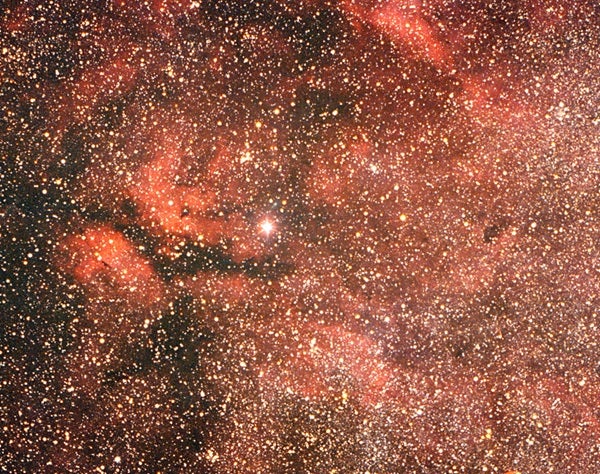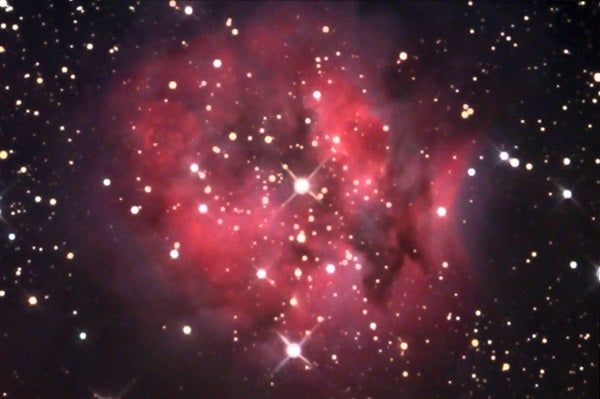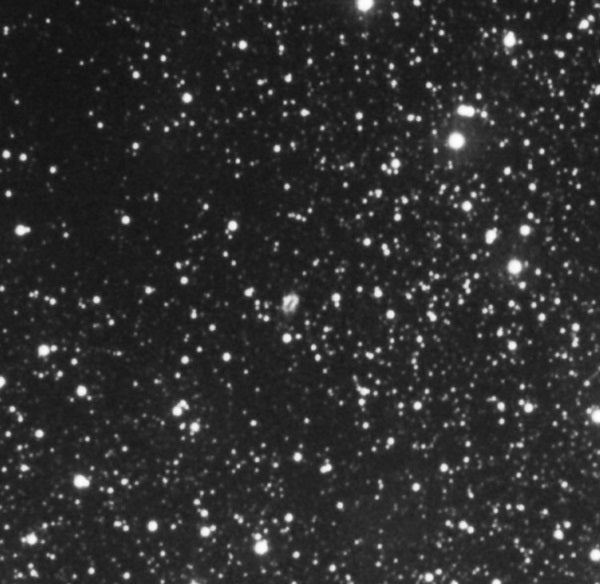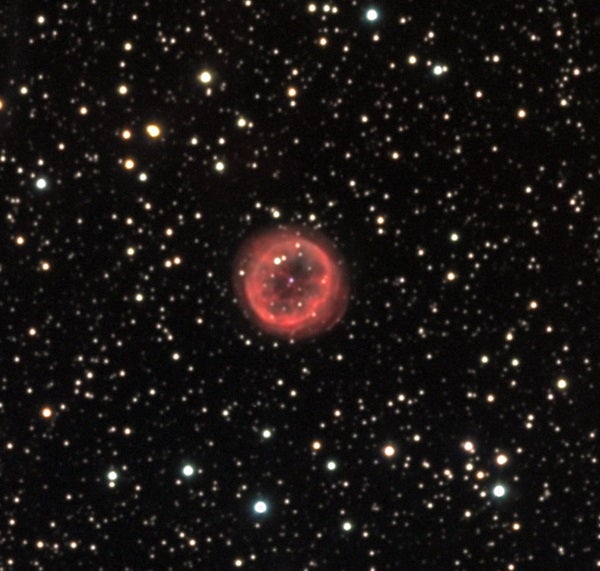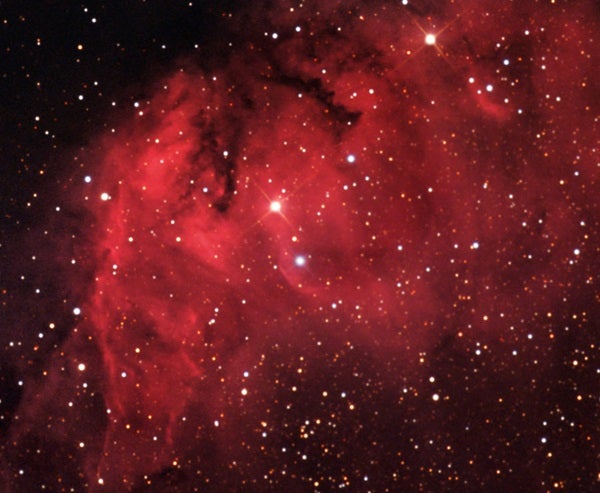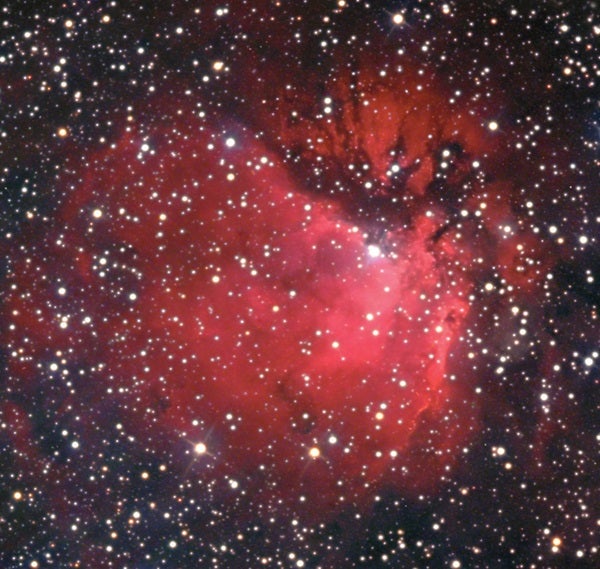After you’ve seen the beautiful Veil Nebula (NGC 6960/92/95) and the popular North America Nebula (NGC 7000), take a look at some of Cygnus’ other striking nebulae. Red emission nebulae, blue reflection nebulae, and the supernova remnants known as planetary nebulae abound in the constellation of the Swan. A clear, moonless night, a moderate-size telescope, and some time are all you’ll need to continue your nebula search.
The Butterfly Nebula (IC 1318)
IC 1318 comprises a large area about 2,100 light-years away. Nebulosity surrounds Cygnus’ central star, Sadr (Gamma [γ] Cygni). The Butterfly is a bright, apparent magnitude 14.9 emission nebula that measures about 240′ across.
IC 1318 comprises a large area about 2,100 light-years away. Nebulosity surrounds Cygnus’ central star, Sadr (Gamma [γ] Cygni). The Butterfly is a bright, apparent magnitude 14.9 emission nebula that measures about 240′ across.
IC 5146 is both a blue reflection nebula and a red emission nebula. Hydrogen gas envelops an open star cluster containing several 12th-magnitude stars. The Cocoon, which lies about 4,000 light-years distant, has an apparent magnitude of 7.2 and spans 12′. Find the Cocoon Nebula about 2° below and to the right of magnitude 4.5 star 81 Pi2 [p2] Cygni.
Jay Gabany
The Cocoon Nebula (IC 5146)
IC 5146 is both a blue reflection nebula and a red emission nebula. Hydrogen gas envelops an open star cluster containing several 12th-magnitude stars. The Cocoon, which lies about 4,000 light-years distant, has an apparent magnitude of 7.2 and spans 12′. Find the Cocoon Nebula about 2° below and to the right of magnitude 4.5 star 81 Pi2 [π2] Cygni.
IC 5146 is both a blue reflection nebula and a red emission nebula. Hydrogen gas envelops an open star cluster containing several 12th-magnitude stars. The Cocoon, which lies about 4,000 light-years distant, has an apparent magnitude of 7.2 and spans 12′. Find the Cocoon Nebula about 2° below and to the right of magnitude 4.5 star 81 Pi2 [π2] Cygni.
Peculiar, asymmetric planetary nebula PK 68-0.1, also known as M1-75, consists of two contiguous shells. The nebula is faint at 16th magnitude, and its disk’s diameter is about 10″. Try 140x and a UHD filter to help bring PK 68-0.1 into view. Find it about 14′ north-northeast of the magnitude 6.9 star SAO 69343.
Martin C. Germano
PK 68-0.1
Peculiar, asymmetric planetary nebula PK 68-0.1, also known as M1-75, consists of two contiguous shells. The nebula is faint at 16th magnitude, and its disk’s diameter is about 10″. Try 140x and a UHD filter to help bring PK 68-0.1 into view. Find it about 14′ north-northeast of the magnitude 6.9 star SAO 69343.
Peculiar, asymmetric planetary nebula PK 68-0.1, also known as M1-75, consists of two contiguous shells. The nebula is faint at 16th magnitude, and its disk’s diameter is about 10″. Try 140x and a UHD filter to help bring PK 68-0.1 into view. Find it about 14′ north-northeast of the magnitude 6.9 star SAO 69343.
NGC 6894, also known as PK 69-2.1, is a faint 14th-magnitude planetary nebula that appears as a pinkish spherical shell surrounding a 17th-magnitude star. The nebula measures about 44″ by 39″ and lies about 4,000 light-years away. To locate NGC 6894, start at magnitude 2.5 star 53 Epsilon [ε] Cygni, star-hop down to NGC 6960 in the Veil Nebula, then scan right about half the distance to the cross’s bright vertical line of stars.
Adam Block / NOAO / AURA / NSF
NGC 6894
NGC 6894, also known as PK 69-2.1, is a faint 14th-magnitude planetary nebula that appears as a pinkish spherical shell surrounding a 17th-magnitude star. The nebula measures about 44″ by 39″ and lies about 4,000 light-years away. To locate NGC 6894, start at magnitude 2.5 star 53 Epsilon [ε] Cygni, star-hop down to NGC 6960 in the Veil Nebula, then scan right about half the distance to the cross’s bright vertical line of stars.
NGC 6894, also known as PK 69-2.1, is a faint 14th-magnitude planetary nebula that appears as a pinkish spherical shell surrounding a 17th-magnitude star. The nebula measures about 44″ by 39″ and lies about 4,000 light-years away. To locate NGC 6894, start at magnitude 2.5 star 53 Epsilon [ε] Cygni, star-hop down to NGC 6960 in the Veil Nebula, then scan right about half the distance to the cross’s bright vertical line of stars.
Sh2-101 is a 9th-magnitude, irregular-shape, bright emission nebula that measures about 16′ by 9′. The Tulip is located some 8,700 light-years away. Look for the Tulip Nebula to the left of 4th-magnitude star 21 Eta [η] Cygni, which lies about 5° beneath and right of magnitude 2.5 star Sadr (Gamma [γ] Cygni).
Brian Lula
The Tulip Nebula
Sh2-101 is a 9th-magnitude, irregular-shape, bright emission nebula that measures about 16′ by 9′. The Tulip is located some 8,700 light-years away. Look for the Tulip Nebula to the left of 4th-magnitude star 21 Eta [η] Cygni, which lies about 5° beneath and right of magnitude 2.5 star Sadr (Gamma [γ] Cygni).
The Clown Nebula
Sh2-112 is a bright emission nebula about 9′ by 7′ in size. To find the Clown Nebula, look for a small red dot of nebulosity to the right of magnitude 1.5 star Deneb (Alpha [α] Cygni).
Sh2-112 is a bright emission nebula about 9′ by 7′ in size. To find the Clown Nebula, look for a small red dot of nebulosity to the right of magnitude 1.5 star Deneb (Alpha [α] Cygni).

